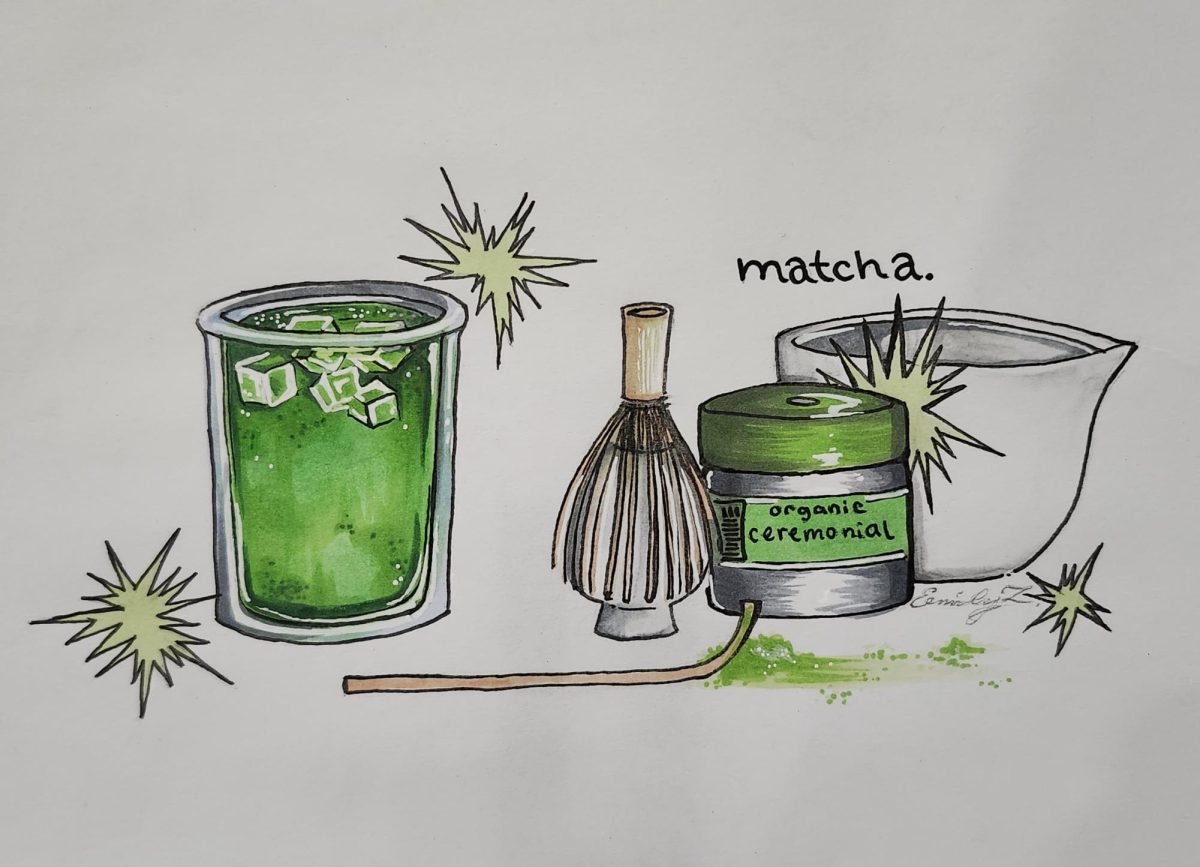Matcha, the bright green drink that’s become such a viral sensation in recent months that even online Japanese vendors are frequently sold out, has origins that date back to the 7th-10th century. The overwhelming presence on social media has created connoisseurs and matcha-thusists; however, why has it suddenly surged in popularity?
The tea’s origins stem from China during the Tang Dynasty, where green tea leaves were steamed and formed into bricks to preserve them when transporting long distances to trade. Then the leaves would be roasted and ground into a fine powder which is known as matcha. Despite originating in China, matcha is best known for being grown in Japan. This is because Eisai, a Japanese Monk who was studying Buddhism in China, had brought the tea and practice of preparing matcha to Japan.
Matcha is now harvested typically in Japan because of the ideal climates found roughly in the center and southern regions. Although it’s possible to grow matcha elsewhere, the best quality is produced straight out of Japan. Matcha.com, a reputable matcha brand unpacks the differences of matcha grown in China as opposed to Japan. Comparing the color, texture, taste, nutritional benefits, pesticide exposure, and even soil qualities that make all the difference in quality of matcha. It requires a lot of shade to grow properly and be rich in its flavor; however, there are multiple varieties of the tea leaves, which differ slightly in taste. They can also develop different flavors because of the different weather conditions that span across Japan.
The rise of matcha on the internet doesn’t seem to have any one cause. However, it’s likely because of its popularity in cafes, since American culture almost universally loves a sweet treat. Social media makes everything more accessible, allowing influencers and even ordinary people to post content and connect across the world. Considering how many American people drink coffee, it isn’t shocking that matcha has gained so much traction here in the West. Matcha is a caffeinated beverage and although sharing similar effects as coffee, it provides more calming effects. Gen Z especially has hopped onto the trend because of Matcha’s health benefits, and doesn’t seem to be letting go of it anytime soon.
“There are actually many health benefits to drinking matcha tea. It’s rich in antioxidants, which help with preventing cancer growth, heart disease, diabetes, and it even has positive effects when it comes to weight loss.” Maria Jurasek, a registered nurse from Northwest Community Hospital said.
Matcha holds many perks to wellness, mainly due to the fact it contains catechins. According to Matcha Direct, “Catechins contribute to tea’s distinct bitterness and astringency, but they also possess strong antioxidant properties, helping to protect cells from harmful substances and contributing to overall health”.
The caffeine and L-Theanine in matcha also helps improve brain function and helps reduce stress. Harvard Health Publishing mentions that the polyphenols in matcha have anti-inflammatory properties and can also help improve insulin sensitivity.
However, the drink is not without shortcomings. Matcha contains caffeine, so having too much can result in headaches, anxiety and stomach aches. Consuming too much matcha can cause high blood pressure, liver problems, and impact iron absorption.
When it comes to quality there are typically two types of matcha to look out for: ceremonial and culinary.
Ceremonial-grade matcha is of a higher quality and tends to be more expensive. The leaves are younger and carry more prominent flavor profiles. Additionally, the powder appears to be a brighter and more vibrant green. When it comes to a latte and or beverages, ceremonial matcha is typically used.
Culinary-grade matcha is primarily used in baked goods. The leaves are older and tend to leave a more grassy note, while the powder is noticeably more dull. The cost of culinary matcha is significantly cheaper, but the quality is incomparable to that of ceremonial grade. It isn’t uncommon to drink culinary matcha, but many individuals who aren’t well-versed in the tea may be left with a bad impression. Culinary matcha tends to have a more intense grassy and bitter flavor, which can make it unpleasant to drink.
Through the evolution of matcha and the exposure of it across the world, cafes have put their own spin on the beverage. Modern recipes have created a lot of hype and promotion on social media. Particular recipes that seem to be growing in popularity are banana cream, banana pudding, and strawberry matcha. Typically seen in lattes, baristas along with matcha lovers have altered the classic formula by adding syrups, cold foam and even fruits.
College of Dupage Student, Itzel Carrasco, posts photos of matcha creations on her Instagram story. Although it’s becoming very popular to post content regarding matcha, it hasn’t always been this way.
“On TikTok, I didn’t see much on like matcha, but more, I guess. Like last year, coming into this year, I’ve seen a lot more people trying it, liking it, making new recipes, adding different flavored syrups. Obviously using different milk alternatives, like oat milk, almond milk. But, I feel like it’s getting more popular now, now that people are adding different syrups or just experimenting with matcha in general.” Carrasco said.
Drinking matcha isn’t a cheap hobby. A singular 1 ounce tin of matcha typically ranges from $20-$40 dollars depending on the brand. When comparing the prices of cafe matcha to making your own at home, it’s more cost-effective to purchase your own powder. Doing research about quality and reviews on certain brands is essential to finding the tea that best suits your preference in taste and price point.
When creating matcha there are multiple pieces of equipment that also add to expenses. The equipment can consist of a bowl, whisk (bamboo or electric), sifter, and a scale if you want to be fancy with measurements. All of this plays a role in enjoying the process of making the tea and practicing mindfulness, something that’s very traditional in Japanese tea ceremonies.
Whether matcha will maintain its popularity remains to be seen, considering how fast trends rise and fall. The unique flavor profile has a grasp on people worldwide, regardless if it’s used in lattes or desserts. Matcha holds many health benefits that play a role in wellness. Matcha is more than just an internet trend, its history and cultural significance are just as valuable as the drink itself.









